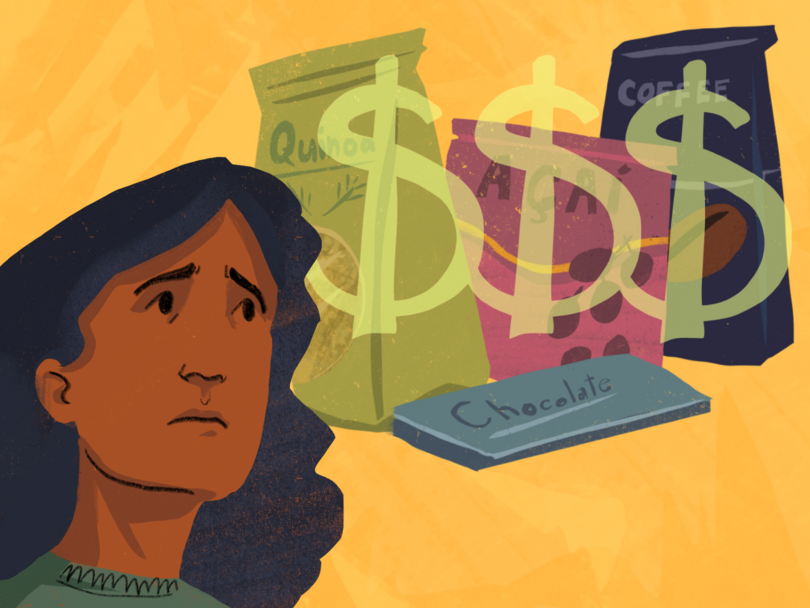Opinion: U.S. superfood trends make accessing cultural staples harder

The privilege of choosing a particular diet is often overlooked. Our columnist writes that food consumption should spark conversations regarding global solidarity and ethical decision-making. Flynn Ledoux | Illustration Editor
Get the latest Syracuse news delivered right to your inbox.
Subscribe to our newsletter here.
Dietary trends come and go, but a recent surge is the rising popularity of “superfoods.” Their consumption has become a symbol of health and wellness, featured as an organic health-conscious choice with few negative consequences.
Behind the flashy packaging and marketing strategies lies a reality that many people, particularly those of us living in wealthier countries, overlook: the freedom to choose a diet is a privilege.
The price of that privilege is often paid by children and families in third-world countries who are trapped without agency in cycles of underpaid labor and exploitation.
The United States has grown accustomed to outsourcing our food production to other countries, particularly in the Global South. But while these countries provide us with ingredients that fuel our increasingly diverse diets, their populations bear the brunt of the costs.
Quinoa, for example, grown in South America’s Andes mountains, is a grain that’s remained a staple food in Indigenous communities for centuries.
Yet, prices on quinoa are skyrocketing due to the high demand that the western world’s health-conscious consumers have on the grain, alienating Indigenous communities from the foods they produce and rely on.
Quinoa isn’t the only crop to become unattainable after superfood demand spikes. Coffee, chocolate and rare fruits like acai are examples of other exports fluctuating in availability.
As the demand for these superfoods rises, the pressure to increase production grows, often leaving the social and environmental impacts on the communities where these foods originate to be ignored.
One of the most overlooked impacts is the exploitation of children who work in crop fields. In the Global South region, children are sent to work at an early age — often in dangerous conditions — which shows how the demands of the West overpower humanity in supplier countries.
Superfoods sound appealing, especially when we don’t need to consider it a luxury to pick and choose foods that align with our values and instantaneous desires.
But this choice comes at the cost of the children who are harvesting quinoa in the Andes, the farmers who are paid a fraction of the price they deserve and the ecosystems being ravaged to meet the demands of a global food system.
This doesn’t mean we must stop eating quinoa or other imported health foods entirely. Instead, we need to approach our food choices with deeper awareness and responsibility.
We must demand transparency from food producers, advocate for fair wages and working conditions for those who grow our food and support sustainable practices that don’t exploit people and developing communities.
We can’t continue to ignore the human and environmental costs of our personal food choices. Each purchase of a food item is a reflection of the practices behind its production.
It’s crucial to understand that the price of food is the exploitation of workers and the degradation of our planet, not just the digits that follow the dollar symbol.
As consumerism rises, we must hold companies accountable for their unethical practices while supporting brands that champion human and environmental rights.
One sustainable practice we can implement into our daily routine is sourcing local produce, as opposed to fixating on foods that need to be outsourced and that fuel exploitation. We as a community can emphasize to our local leaders the importance of fair trade certification, assuring ethical practices in our pursuit of dietary refinement.
Most importantly, we must recognize that the act of choosing a diet is a privilege, and with that privilege comes an obligation to ensure our choices don’t harm others.
For international students at Syracuse University, the effects of this global food system can feel even more personal. For students coming from countries that rely on “superfoods” for their diet and cultural identity, it can be harder to find dietary comfort.
But, when these foods are commodified and shipped overseas, both countries face obstacles.
In America, the price for a simple bag of quinoa or another traditional food for international students may be higher domestically. In the origin country, the foods go from cheap staples to expensive foreign desires. They’re made inaccessible in each scenario.

Joe Zhao | Design Editor
International students are thus faced with the dilemma of either paying egregious prices for foods that remind them of home or accepting a foreign diet that doesn’t reflect their cultural customs. The disconnect from familiar, nourishing foods can lead to food insecurity, exclusion and alienation.
The cost and exotification of global food staples is a stark reminder that, at the expense of international students and Indigenous people alike, the privilege of choice in diet remains in the hands of those who can afford the luxury.
Instead of neglecting the larger social implications, domestic students should be mindful of this disparity and keep in mind how their consumer choices affect their peers.
Support local food producers at the CNY Regional Market, or opt for affordable, sustainable options like the Syracuse Cooperative Market. Show solidarity and compassion for the international students in our community who may have different dietary restrictions and traditions, and realize that starting a new diet isn’t as simple as it sounds for everyone.
Ultimately, the conversation around food consumption should center on global solidarity. By making more informed and ethical food choices, we will unravel hundred-year-old systems that perpetuate inequality and exploitation for the ease of others.
Saimun Uddin is a senior majoring in aerospace engineering. She can be reached at sauddin@syr.edu.





